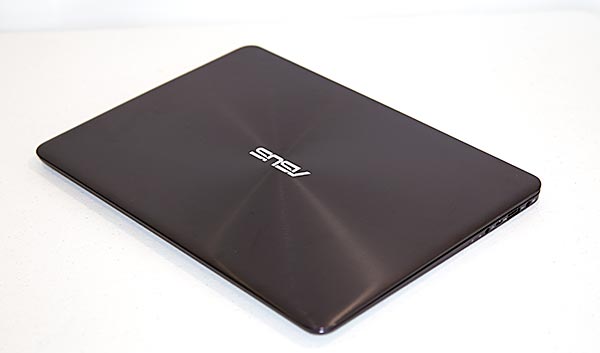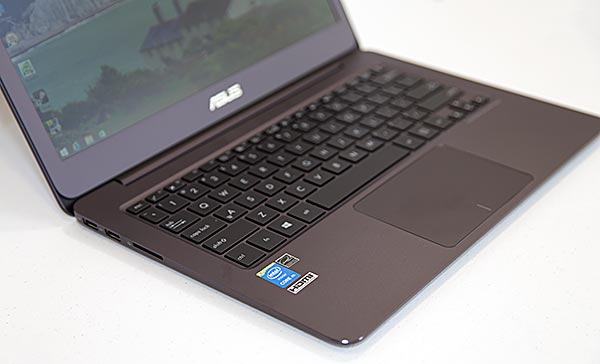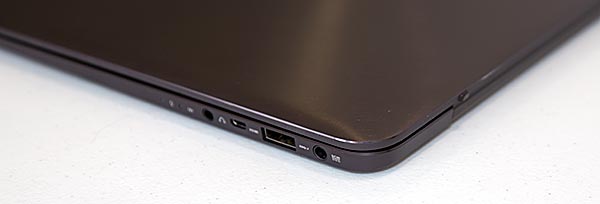|
We need more machines like the Asus Zenbook UX305: stylish, highly portable, quite capable and priced at just $699. We were already impressed with Asus' $899 Zenbook UX303 that was recently refreshed with Intel Core i5 Broadwell CPUs. The UX305 is the more affordable version of the UX303 (higher numbers don't always mean better in Asus' world). But the key point here is that Asus cut very few corners to create the $200 less expensive UX305. You do give up the touch screen, which is the biggest drawback given Windows 8.1's push to use touch, but since it's a pure laptop form factor with no convertible-tablet feature, we'll forgive it. Instead of the Intel Core i5 used in the UX303, the UX305 has the lower power and slower Intel Core M CPU, and the UX305 loses the backlit keyboard. But there's plenty of goodness left: an all metal casing with Asus' signature swirled aluminum lid, plenty of ports, a striking and slim design, and a full HD 1080 matte IPS display (QHD 3800 x 1800 will be available in April 2015 for $999).
Design and Ergonomics
The Asus Zenbook UX305 is a traditional laptop that looks quite similar to previous Zenbook models, from the swirled aluminum lid to the tapered side view. The UX305 particularly reminds us of the 13" MacBook Air with a similar lid and hinge design, a large metal bezel and a keyboard that's a lot like the Air's (that's not a bad thing even though we wish Asus would stop placing the power button where the delete key should be, as does Apple). The entire external casing is made of metal, including the bottom panel that's affixed with several torx T5 screws and two Phillips head screws hidden under the back rubber feet. The metallic plum color is a mix of blue and purple, which isn't my favorite look, but color preference is personal. We've seen Asus use silver, gunmetal, champagne and black on other Zenbook models; clearly they're not afraid of playing with hues. The machine is rigid and we couldn't twist or torque it. If you press really hard on the keyboard deck, it will flex, but it's hard to imagine anyone would apply that much pressure when typing.

Despite its impressive slimness, the Zenbook UX305 has a healthy selection of ports for a 13.3" Ultrabook: 3 USB 3.0 ports, micro HDMI, 3.5mm combo audio, an SD card slot and Gigabit Ethernet via the included USB 3.0 to Ethernet dongle. We'd give Asus a hard time about micro HDMI but there really isn't room for a full size HDMI port and compared to the single port 12" MacBook with which it competes on some fronts, it's doing just fine. Asus includes their usual square charger with a relatively short and thin cord. The UX305 is an attractive looking laptop for the price, though it doesn't hit quite the high note that some more expensive Zenbook models do, since there's less attention to esthetic detail like the flat-cut stainless steel look on the sides of the UX303 or the glass lid of the UX301. But for $699, it's wildly good looking and it keeps up nicely with machines priced considerably higher.
The Intel Core M doesn't require a fan, so the UX305 doesn't have one. That means the laptop is always dead silent, and happily we didn't see significant thermal throttling when the Zenbook worked on heavy loads like Benchmarks and gaming with Skyrim for 30 minutes. The bottom doesn't get hot, but the strip just above the keyboard does get warm to hot--fortunately that's not a place most of us touch often.
Trackpad and Keyboard
The good news first: the keyboard is very good and not noticeably different from the UX301 and UX303, both of which had keyboards we thoroughly enjoyed. Asus might not employ ergonomically shaped keys like Lenovo with their ThinkPads and Dell in the XPS line, but I typed well with the Zenbook UX305. It has 1.2mm key travel, which is a little lower than the 1.5mm travel of larger and thicker laptops, but par for the course with a slim 13" Ultrabook. Unlike most Zenbooks, the keyboard isn't backlit; something had to go to meet the low price point. Happily the black keys and white masking are easy to see even in dim rooms.
The trackpad is fairly large (almost as big as the MacBook Air 13"), and we have the Microsoft Signature Edition that avoids Asus' sometimes tepid drivers. Still, the trackpad was passable but nothing more. It was reliable and didn't skip or falter, but it sometimes missed touches when we tapped, didn't always register two-finger scrolls and the click is loud.... loud enough that my colleague turned to stare at me (granted that's happened with some ThinkPads too). It's not a horrid trackpad, but it's not among the best.

Display
Our $699 model has a 1920 x 1080 IPS matte display. I love matte displays--the much reduced glare doesn't induce eyestrain, and you can set the brightness lower since there's no need to combat reflections. The bad news is that there's no touch screen option, so those of you who actually enjoy using touch in Windows 8.1 are out of luck. Since this is a traditional laptop that doesn't convert into a tablet, it's not an outright necessity, and it did allow Asus to price the UX305 lower. Asus will offer a $999 version with a QHD 3200 x 1800 display in the future, and we'll be interested to see how much it taxes the Core M CPU and Intel HD 5300 graphics.
Like most things in this world, IPS displays come in different qualities, and this isn't the lovely matte non-touch display of the $1,800 MSI Ghost Pro full HD or even that of the UX303. It has noticeable light bleed when displaying dark backgrounds and when booting up. We could see bleed all along the bottom edge and the lower sides that extended about 1.5" toward the center of the display. For those who aren't familiar with the term, light bleed is when the white backlight bleeds out around the edges of the screen, resulting in lighter areas that you'll notice when watching a letterboxed movie. It's not bad enough to affect colorful desktop wallpapers, photos or full screen video playback that has no letterboxing. Again, for the price, we're not going to complain too much, especially when we've seen more expensive Asus models with backlight bleed at the same level a few years back.

The display is fairly bright at 294 nits, and contrast is decent at 500:1 but not stellar (gloss panels tend to deliver higher perceived contrast). Color gamut falls just a few points below the $900 Ultrabook pack at 92% of sRGB, which is still quite good overall and great for a laptop at this price point with a host of good specs. Color calibration from the factory was wildly off, making the panel look cool with excessive contrast (colors were a little blown out). We've seen Asus put out panels with quite good calibration (the UX303), and when they don't, they tend to be hiding panel deficiencies (they're not the only manufacturer to do this). When we calibrated the panel using our Spyder 4 Pro Colorimeter, brightness dropped 10 nits but colors looked more natural and that slight solar flare look was gone.
|
|

